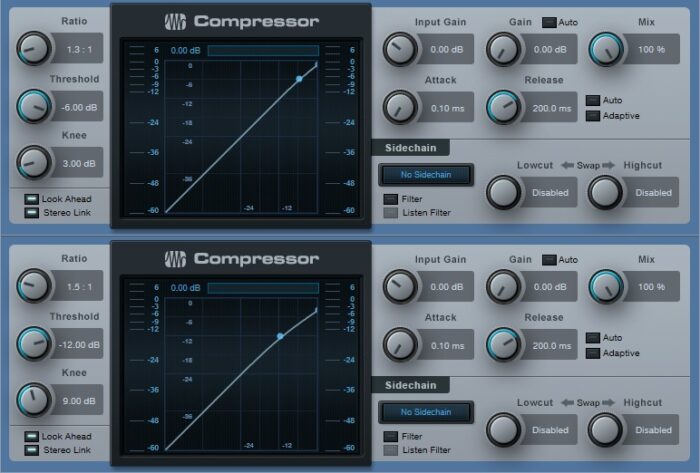If you have a standard compressor, you have what you need for a “glue” bus compressor
If you’ve heard people talk about adding “glue” to a mix, this usually involves a bus compressor. But you can also “glue” tracks together in a subtle way by placing two standard compressors in series with high thresholds, low ratios, and no attack time. The result is dynamics control that’s so gentle, you won’t really hear that a compressor is working—but you will hear the benefits.
It’s difficult to give precise settings because the levels on tracks differ, but if the level going into the first compressor is fairly high—with peaks around -3 dB or so—here are some suggested settings as a starting point.
Initial “Glue” Bus Compressor Settings
Compressor 1: Threshold -6, ratio 1.3 : 1, knee 3 dB, attack 0 ms, release 200 ms
Compressor 2: Threshold -12, ratio 1.5 : 1, knee 9 dB, attack 0 ms, release 200 ms
You’ll need to adjust makeup gain based on the signal levels you’re using. You may also want to increase the attack time if the attack is too abrupt.
With lower input levels, lower compressor 1’s Threshold control but note that these settings are optimized to work with higher signal levels, like what you’d expect from program material. It’s not intended to work like a conventional compressor that flattens an input with a highly variable level, although you can always increase or lower the ratio or threshold for the best sound.
Now, try the following test with a finished mix:
- Loop part of the program material with the compressors bypassed, and note the maximum level.
- Observe the maximum peak values.
- Re-enable the compressors.
- Adjust the second compressor’s makeup gain so that the peak value is the same that you noted in step 2.
- Bypass the compressors as a reality check. The effect should be noticeable, but not hit you over the head.
Happy squashing—or perhaps more appropriately, happy anti-squashing.
